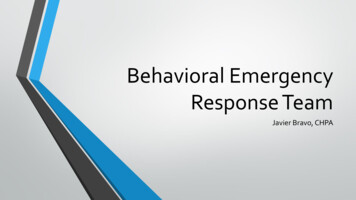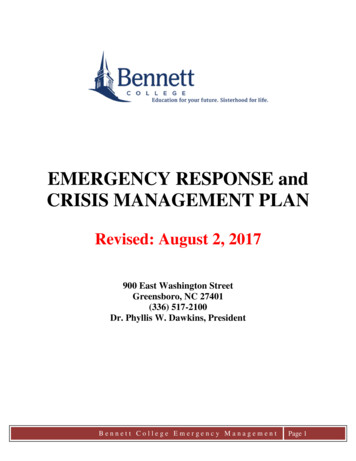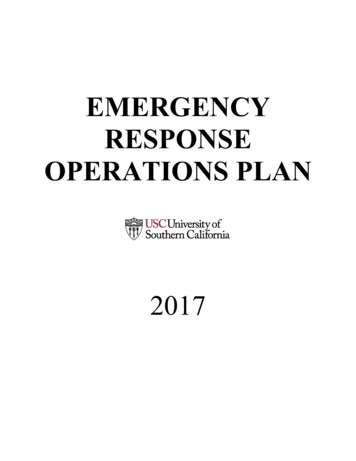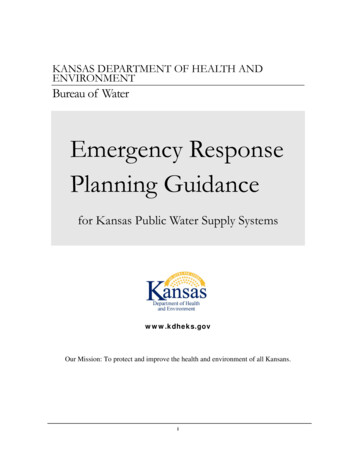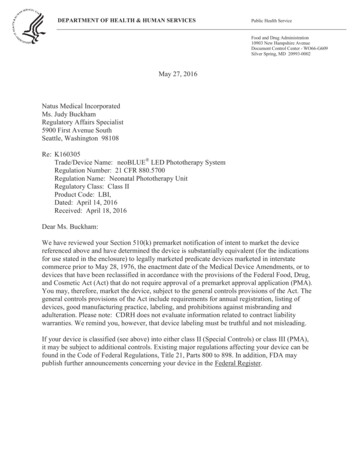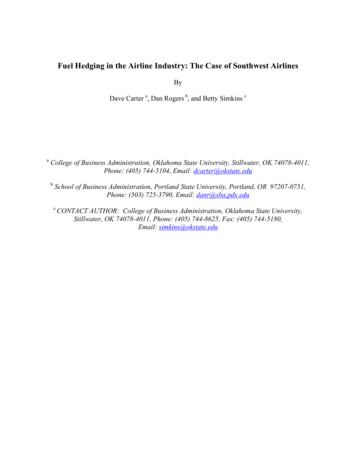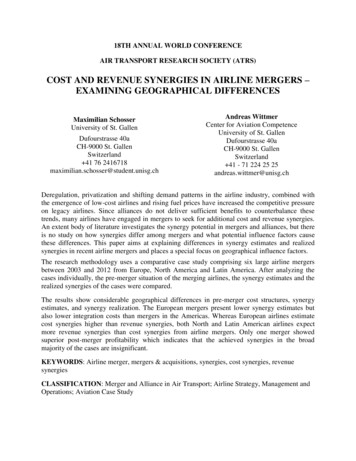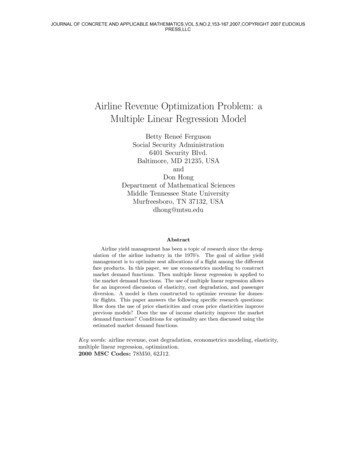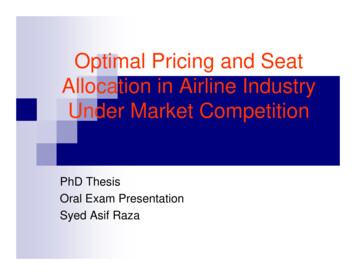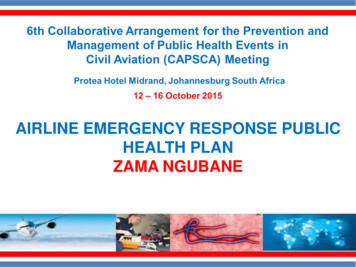
Transcription
AIRLINE EMERGENCY RESPONSE PUBLICHEALTH PLANZAMA NGUBANE
Airline Emergency ResponsePublic Health Plan Adhere to IATA Communicable DiseaseGuidelines Corporate Emergency Response Plan Departmental Recovery Plan (MS)Alarm & Contact Notification Document Presentation will commence from groundprocedures to on board processes andnotification procedures that follows
AIRLINE EMERGENCY REPONSE PUBLICHEALTH PLANDAICY DEMAS
o South African Airways (SAA) – Airport Operations hasestablished a clear procedure in response to asuspected communicable disease or passengers with illhealth with the potential to pose a serious public healthrisk.o The procedure is documented in the CustomerProcedures Manual: Section 2 Chapter 39 as well as inthe 14 CFR Part 382 learner guide.o SAA procedure adheres to IATA Communicable Diseaserecommended guidelines in collaboration with the WHO.
Ground Staff Screening Processo A communicable disease is suspected by ground staff,when a customer : Has a visible skin rash Has a severe cough Is obviously unwell Has a high feverand complains of the following :
Severe cough Fever Bruising or bleeding without previous injury Persistent diarrhoea A non-visible skin rash Persistent Vomiting
o When ground staff suspect that a customer displaysthese signs or symptoms, they : Call their Team Leader / Supervisor immediately If Team Leader / Supervisor shares the same concern,contact the SAA Medical Department / ExternalPhysician / Airport Medical Facility / Port Health If medical support is not immediately available, customerwill be denied boarding and customer asked to consult aphysician and request a medical clearance before travelis accepted
Procedure if a communicabledisease is suspected and acustomer is denied boardingo Customer’s baggage will be offloaded. Recommendedthat ground staff wash their hands with soap and waterafter handling the baggage.o Assistance will be provided if customer requires to beescorted. Masks to be worn / Tissues used to cover boththe customers / airline staff’s mouth.
o In terms of Article 32 of the WHO International HealthRegulation, SAA will treat customers with dignity and tryto minimise discomfort. If a translator/interpreter isneeded, we will try our best to arrange one.o In some countries (eg: USA) , the Customer ComplaintResolution Official (CCRO) must be involved.o Ground Staff / Airport will inform Customer Care ofdecision take and provide additional information.
Procedure if a communicabledisease is suspected and acustomer is allowed to boardo This should not happen as staff are aware of theproblems associated if this is allowed.o Seek guidance from SAA Medical department.o Airline staff to note on General Declaration and adviseCabin Crew.o Destination airport to be advised.
What SAA has Implemented Training Course that is mandatory for all ground staff toattend within 36 months (every 36 months). The trainingcourse explains important and essential aspects ofcommunicable diseases. This will equip ground staff toeffectively screen customers and forms part of the USDOT Part 382 training. Training records are available at the training section. Regular audits are carried out to ensure that ground staffknow procedure to follow.
Communicable Disease flashcards available at all check-in and ticketingcounters, for staff to refer to Masks , gloves and hand sanitizers readily available. Communiques distributed by Medical Department to all SAAemployees when faced with a suspected case of a communicabledisease, so that all are informed of WHO updates. Briefing reminders.
General Declaration ICAO made changes to the General Declaration –Declaration of Health. SAA requested these changes in 2014 from Amadeus. They have lodged a service request and all carriers hadto approve this. The final approval was obtained and the changes will bereflected by end of 2015.
General Declaration Ground staff will print a gen dec for each flight and handover to the crew. The crew will update any incidents on board and onarrival hand the gen dec to Port Health.
Changes Made to Gen Dec NAME AND SEAT NUMBER OR FUNCTIONS OF PERSONS ON BOARD WITHILLNESSES OTHER THAN AIRSICKNESS OR THE EFFECTS OF ACCIDENTS, WHO MAY BESUFFERING FROM A COMMUNICABLE DISEASE (A FEVER, TEMPERATURE 38ºC/100.F OR GREATER,ASSOCIATEDWITHONEORFOLLOWING SIGNS OR SYMPTOMS:MOREOFTHE
Changes Made to Gen Dec APPEARING OBVIOUSLY UNWELL; PERSISTENT COUGHING; IMPAIRED BREATHING; PERSISTENT DIARRHEA PERSISTENT VOMITING;
Changes Made to Gen Dec SKIN RASH; BRUISING OR BLEEDING WITHOUT PREVIOUS INJURY; OR CONFUSION OF RESENT ONSET,INCREASES THE LIKELIHOOD THAT THE PERSON ISSUFFERING A COMMUNICABLE DISEASE) AS WELL ASSUCH CASES OF ILLNESS DISEMBARKED DURING APREVIOUS STOP.
THANK YOU
SUSPECTED COMMUNICABLE DISEASEGUIDELINES FOR CABIN CREW
Guidelines for Cabin CrewSUSPECTED COMMUNICABLE DISEASE ON BOARDA temperature above 38 degrees CelsiusAssociated with one or more of the followingAppearing obviously unwellPersistent coughingPersistent diarrhoeaImpaired breathingPersistent vomitingSkin rashBruising or bleeding without previousinjuryConfusion of recent onsetHistory of travel in last 21 daysAsk Accompanying Pax of any similar symptomsNote : If the temperature of the affected person is normal but several travellers havesimilar symptoms think of other public health issues such as chemical exposure
NOTIFICATION ON BOARDReport suspected caseCOMMANDEROCCATCINTERNAL PROCESS ACTIVATEDERP / MEDICAL SERVICES
On Board Action PlanSuspected Communicable diseaseRelocate adjacent passengers2meters between ill pax/otherDesignate one crewmemberNo seats available offermasks adjacent pax
Passenger CareRespiratory EtiquetteBlock Off Toilet for specificPax/If no extra toilet availablecrew to educate pax on UPKWashing hands/wiping toiletseat tap handles/doorhandles with antisepticprovided or soap and water
CABIN CREW CONCERNS-EXPOSUREWhen Exposed to Body Fluids TRAINING FROM MNORT Inception of High Level PPE Identifying the GAPSHot/Uncomfortable/Pretty Scary for crewCrew much more Relaxed REMOVAL suit even More important INTENSIFIED TRAINING PRIOR TOFLIGHT AND IN RECURRENTTRAININGProper Donning and RemovalKey Aspect of Training
Flight Operations OM Part 1 Chapter 9 Rev 15 Cabin Crew to inform the Captain of the passenger withsuspected communicable disease Captain to notify ATC (to allow for notification of Port Health Captain to notify the SAA GOCC (request disinfection of a/c) Captain to complete the Communicable Disease – GENDEC Annual training by the Aviation Medical Department
FOLLOW UP/TRACING PASSENGER LOCATOR FORMS GENERAL DECLARATION FORMS TO BECOMPLETED BY CABIN CREW FOR PAX ROWSFORWARD/AFT/SAME HANDED TO PORT HEALTHON ARRIVAL
THANK YOU
DR NONHLANHLA SISHABA
Suspected CommunicableDisease on BoardA SENIOR AVIATIONDOCTOR, /A NURSEIS ON STAND BY 24/7 FORAll EMERGENCIES.NOTIFICATIONCOMES THROUGHFROM THE AIRCRAFTVIA OCC – SICK PAX ON BOARD
COMMUNICATION BETWEEN SAA DR/NURSEOCC AND COMMANDER VIA SATCOMDECISION IS MADE ON HISTORY RECEIVED FROM THE CABIN CREW A temperature above 38 degreesCelsius Appearing obviously unwell Persistent coughing Persistent diarrhoea Impaired breathing Persistent vomiting Skin rash Bruising or bleeding withoutprevious injury Confusion of recent onset History of travel in last 21 days If Suspicion is confirmed ERP isactivated via OCC
1. AVIATION EMERGENCY RESPONSEPLAN ACTIVATED R2. MNORT InstructionsFollowed if Pax/CrewHospitalized
CREWMEMBER MANAGEMENTPOST INCIDENT A GROUP DEBRIEFING GROUP POST COUNSELLING INDIVIDUALISED PROFESSIONALPOST COUNSELLING PRN CREWMEMBER MEDICAL FILE DOCUMENTED CONTINUED MONITORING/WELLNESS MANAGED FITNESS TO RETURN ESTABLISHED
AIRLINE EMERGENCY RESPONSE PUBLICHEALTH PLANZAMA NGUBANE
NOTIFICATIONDestination AirportproceduresATCCOMMANDERDr on BoardPORT HEALTH/ACSAAOCC INTERNAL PROCESS ACTIVATEDMEDICAL SERVICES /ERP
TIER 11. Flight Commander notifies ATC and Airline OCC via SAT phones/2. OCC MOD conducts conference call wit h Commander & CMO for assessment and implementation ofplan purposes ( if applicable)3. OCC conducts Crisis Assessment Call (CAC) with Business Continuity Committee (HOD’s) to initiatethe ff: activate ECC/Standby-TEC/1st Media Statement4. OCC additionally notifies MCC and forward activation messages to ECC members ( relevantdepartments)TIER 2MCC notifies GH of a suspect contact case on board (Swissport & BidAir) for A/C cleaningand baggage services purposes Technical Clinic (drop of Biohazard waste ) Biohazard Waste collection and disposal Service ProviderTIER 3ECC manages and direct: BC Plan( LIC- manages and internal info centre airline airport ops activities) Supported and guided by CMO (subject matter expect and liaison with DOH) Conduct of media statement and releases Customer Service care – Health updates/ business standpoint and awareness TEC service activation ( if required)TIER 4Crisis Communications and BC Internal & external communication statement releases and updates MS continuous updates through pandemic awareness travel and DOH notices MS high visible presence for employees ( Clinic and site visits) Utilise strike contingency plan , personnel roster (skeleton staff)
AIRLINE ACTIVATION / NOTIFICATIONOCCRelevantStakeholders:AirlineCACSAA LICRegular OPSIrregular uthorityPortHealthM>elephone EnquiryCentreMedical ServicesCustomer Services
BC follow up steps: SAAT and Clinic Logistic:- BidAir (A/C cleaning)- Swissport (baggage services) Cargo Crisis Communications Q&A
BIO-HAZARDOUS WASTE&AIRCRAFT PEST CONTROLBEN WHITE
BIO-HAZARDOUS WASTE Waste generated during communicable diseaseincidents on-board an aircraft. Contaminate material e.g. seat cushions, seat covers,blankets, carpets, etc. Material is removed and sealed in plastic bags by groundhandling agent and transported to SAAT s bio-hazardouswaste area. Disposal done via incineration
BIO-HAZARDOUS WASTE Major incident – when Port Health place aircraft underquarantine. SAA aircraft is towed to SAAT premises. Contaminated area is disinfected by bio-hazardouswaste contractor. Aircraft declared serviceable by Port Health afterdisinfection completed.
SAA TECHNICALAVIATION PEST MANAGEMENT Pest Management Industry in SA and the Legislativerequirements, History & Significance of Aviation Pest Management, Integrated Pest Management Programme on aircraft:Elimination of crawling & flying insects as well asrodents,
SAA TECHNICALAVIATION PEST MANAGEMENT Procedures used: Disinsection, Disinfestation,Disinsectization, De-ratting & Fumigation; Other Aircraft Disinsection Techniques: Non-toxicTrapping, Mechanical Trapping and Vacuuming; Pesticides used on aircraft:Tested and Approved,
SAA TECHNICALAVIATION PEST MANAGEMENT Safety in the transportation, handling and application ofPesticides; Pest Management: A vital link between Vectors ofcommon Disease and Public Health, Closing.
MEDICAL CENTREOccupational Health) Aircraft disinfection kits for disinfection of contaminatedsurfaces are packed and dispatched to stores and Linestations. Calla 1452 disinfectant is the one used to disinfectcontaminated surfaces
MEDICAL CENTREOccupational Health) In the change of HEPA-filters on the aircraft and safedisposal thereof, enforcement on the wearing of PPE isstrictly monitored to control to prevent the spread ofrespiratory diseases. Demonstrations are held for the correct fitting of PPE fortechnicians.
THANK YOU
AIRCRAFT CLEANINGBUSHY M
BIDAir Services (Pty) Ltd is an all SouthAfricanorganisationrenderinggroundhandling services to a broad spectrum ofDomestic, Regional and International airlinesat 6 ACSA airports within South Africa.- As an ISAGO Accredited Ground HandlingAgent all procedures pertaining to all areas ofoperation are documented and implemented?Reaccreditation begins in the first 6 months ofnext year.IATA / ISAGOWHOCATS & CARS
- Certain Ground Personnel are familiar withWorld Health Organization (WHO) globalinfluenza preparedness plan, but not a largesection,onlycriticalmanagement,supervisory and Team Leader members?2009
- However, BIDAir Services has a detailedLocal Emergency Response and ContingencyProcedures 2015 Manual which contains achapter (19) on Mass Sickness (Managementof Public Health Events in Civil Aviation)which has had sections tested over the lastfew years from the days of “Swine Flu”through to events with Ebola last year2009
-All personnel at BIDAir Services undergo atraining programme, made up of two areas,mandatory training and functional training.Mandatory training (initial training valid for 24months) includes:- Airside Safety Aviation Security Awareness Communicable Diseases – This includes asection on Ebola.
Dangerous Goods Human Factors Refresher training coincides with the bi annualissue of the Airport Permit Chapter 1.11 deals with all the requirements ofstaff development.
Functional Training – Each staff memberwill attend whatever course is required forthem to perform their function: Aircraft Cleaner Baggage Driver Passenger Handling AgentAll staff must write a test and where systemsor equipment are operated they must also becertified as competent to do the designatedtask.
As cleaners do not interface directly withpassengers it is not required that they arefamiliar with procedures regarding promptassessment, care and reporting of illtravellers. At the time of heightened activity of publichealth events, presentations were done tothestaffaboutEbolaandallthepreventative measures required to be safe.
Furthermore staff notices were left onNoticeBoardsaswellasDutyManagement are updated daily with thelatest developments regarding the healthevent.
AIRCRAFT CLEANINGDuring Heightened Public Health Events inCivil Aviation the cleaning has to befocused as follows: Contaminated area of the aircraft – Aspecial team is dedicated to this event. Bio Hazardous disposal of thecontaminated human matter General Cleaning of the aircraftReference
ReferenceAIRCRAFT CLEANING- A cleaningcontaminated areas of an aircraft.TheEmergencyCleaning Kit- This team are familiar with all the cleaninghas beenrequirements of a cordoned off area, wheremade upthe cabin has been contaminated.-based on theAn Emergency Cleaning Kit is kept at the IATA UniversalBIDAir Grooming Stores and is to be used Precaution Kitin such a case.
AIRCRAFT CLEANINGDuring handling of a public health eventcontaminated aircraft, cleaning crews will: Wear impermeable disposable gloves andwhere applicable will wear bio hazard suits. Remove and dispose of the gloves whensoiled. This becomes part of the “biohazardous” waste to be disposed of. Hands are washed with a sanitizer afterremoving the gloves.Reference
AIRCRAFT CLEANINGReference Disinfect upholstery, carpets, and nfluids.beforeanyvacuuming to prevent re-aerosolization All soiled materials are placed in the “biohazardous material” bag, which is thensealed, labelled and taken to the SAATechnical Area where there is a designatedhandling point.
Additional Measures are implemented duringWorld“heightened public health events in civilHealthaviation” and these include: Daily status up date by Port Health. This looks at particular flights from thehigh risk areas and in particular at anyflight reports received which require theuse of the Emergency Kit or EmergencyTeam.OrganisationGuidelines
Duty Manager briefings to cleaning crews,Worldallocation of resources, PPE and use ofHealththe emergency kit. Enforcement by observation anddisciplinary action to ensure staff wearapplicable PPE in all areas of the aircraftcleaning. Disinfectants are used for hand cleaning All cleaning equipment is thoroughlydisinfected after each use.OrganisationGuidelines
THANK YOU
AIRLINE BAGGAGE SERVICES PROCEDURESBALI MABENA/ ZAMA NGUBANE
Baggage Services will receive notification from Local Information Centre(LIC) with detailed passengers information. Airline OCC will notify the Ground Handler – currently Swissport to initiatedSecurity Check. Swissport will be given detailed information of the customer’s baggage. Once the passenger is offloaded, the baggage will also be offloaded. Swissport will hand over the bag to SAA Baggage Services team
Baggage Services will always wear protective cloves as a precautionarymeasure when handling the bag. The team will continuously wash theirhands when touching the bag. This will be done, even though there’s no evidence of the spread ofdisease through baggage contact Baggage Service will open an On Hand file on World Tracer System. They will contact the passenger to reunite them with their baggage.
Baggage Handling In an event that the passenger is hospitalised or is unable to collect theirbaggage, we will contact next of kin to arrange delivery to their preferredaddress. Baggage Services will clear Customs on behalf of the passenger. Baggage Services will arrange delivery of the bag to the passenger’spreferred address.
Baggage Handling Once the delivery is confirmed, Baggage Services will update WorldTracers system with BDO information of who received and signed for thebag. World Tracers file will be closed.
Service Level Agreement South African Airways does not have an SLA specifically addressingBaggage Handling of Communicable diseases This is due to fact that WHO declared that there was no evidence thatinfection had been or could be transmitted by Cargo or Baggage Handling.References: IATA Communique of March 2015
Service Level Agreement The current SLA focus on Security Checks Offloading. The offloading of baggage will be: Narrow Body Aircraft Check to be completed within 10 minutes Wide Body Aircraft Check to be completed within 15 minutes
Baggage and Passenger AssistanceMary Mamabolo – Swissport SA Pty Ltd.
Handling of Arrival Flights with Suspected Cases Notification Process for suspected passenger(s) on board.Airline Crew/PICReport to OCC forBriefing, PPE Issue& Team Dispatch toparking bayATCBUM/SHEQR/Handling TeamsAMC(Airline/PHO/Authority/GH)(Airline/GH OCC)
Handling of Arrival Flights with Suspected Cases(Cont.) Team Briefing session items; Confirmation that handling involves a passengersuspected with communicable disease Flight number, Aircraft Registration and Parking Bay Services required e.g. baggage, ramp , wheelchairand PAU services
Handling of Arrival Flights with Suspected Cases(Cont.) Team Briefing session items; Short brief on communicable disease procedures;e.g. awaiting of Port Health Official approval priorservices, etc. Issuance of PPE and the reminder of usage andremoval procedures Team dispatch and constant communication ismaintained with OCC during services
Handling of Arrival Flights with Suspected Cases(Cont.)
Handling of Arrival Flights with Suspected Cases(Cont.) After briefing session, team proceeds to the parking bay for preparation with allrequired equipment. No servicing allowed – await authorization from the Port Health Official. Once authorization has been granted by the Port Health Officer proceed withpassenger disembarkation, baggage, cargo and mail offloading.
Handling of Arrival Flights with Suspected Cases(Cont.)PAU & WheelchairRamp & Baggage Handing of suspected passenger/s is performed under directsupervision of medical personnel Required PPE is only worn when instructed to do so by medicalpersonnel. If there is a risk of direct contact with body fluids, wear therequired PPE. Store all soiled items in a
o South African Airways (SAA) – Airport Operations has established a clear procedure in response to a suspected communicable disease or passengers with ill health with the potential to pose a serious public health risk. o The procedure is
